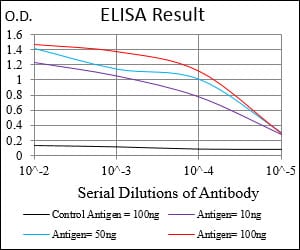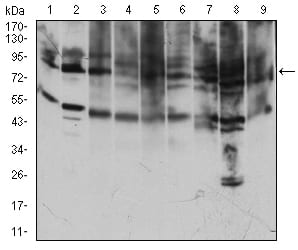

| WB | 1/500 - 1/2000 | Human,Mouse,Monkey,Rat |
| IF | 咨询技术 | Human,Mouse,Monkey,Rat |
| IHC | 咨询技术 | Human,Mouse,Monkey,Rat |
| ICC | 技术咨询 | Human,Mouse,Monkey,Rat |
| FCM | 咨询技术 | Human,Mouse,Monkey,Rat |
| Elisa | 1/10000 | Human,Mouse,Monkey,Rat |
| Aliases | T9; TR; TFR; p90; CD71; TFR1; TRFR |
| Entrez GeneID | 7037 |
| clone | 1A1B2 |
| WB Predicted band size | 85kDa |
| Host/Isotype | Mouse IgG1 |
| Antibody Type | Primary antibody |
| Storage | Store at 4°C short term. Aliquot and store at -20°C long term. Avoid freeze/thaw cycles. |
| Species Reactivity | Human,Mouse,Monkey,Rat |
| Immunogen | Purified recombinant fragment of human TFRC (AA: 608-727) expressed in E. Coli. |
| Formulation | Purified antibody in PBS with 0.05% sodium azide |
+ +
以下是3篇关于TFRC抗体的代表性文献摘要概括:
1. **文献名称**: *Targeting transferrin receptor 1 in malignancies*
**作者**: Daniels TR 等
**摘要**: 该综述系统分析了TFRC抗体在癌症治疗中的应用,指出TFRC在多种肿瘤细胞表面过表达的特性使其成为靶向治疗理想靶点。重点讨论了抗TFRC抗体药物偶联物(ADC)和双特异性抗体的开发进展及临床前效果。
2. **文献名称**: *Anti-TfR monoclonal antibody engineered for improved delivery to the brain*
**作者**: Yu YJ 等
**摘要**: 研究团队通过抗体工程技术改造抗TFRC单抗,增强其穿透血脑屏障的能力。实验显示改造后的抗体在脑部肿瘤模型中的药物递送效率提升3-5倍,为神经胶质瘤治疗提供新策略。
3. **文献名称**: *Structural basis of TfR recognition by transferrin receptor antibody*
**作者**: Cheng Y 等
**摘要**: 采用冷冻电镜技术解析了人源抗TFRC抗体与受体复合物的三维结构,揭示了抗体特异性结合TFRC胞外结构域的关键表位。该发现为开发高亲和力治疗性抗体提供分子设计依据。
4. **文献名称**: *TFRC-targeted nanoparticles for siRNA delivery in ovarian cancer*
**作者**: Shen H 等
**摘要**: 构建了抗TFRC抗体修饰的纳米颗粒,用于靶向递送siRNA至卵巢癌细胞。体外实验显示该载体能显著增强肿瘤细胞对基因药物的摄取,并有效沉默靶基因表达。
注:以上内容为文献核心观点概括,实际引用时需核对原文具体信息。如需完整文献信息,建议通过PubMed或Web of Science检索DOI号获取。
Transferrin receptor 1 (TFRC), also known as CD71. is a transmembrane glycoprotein critical for cellular iron uptake. It binds to iron-loaded transferrin, facilitating its internalization via receptor-mediated endocytosis. This process is essential for maintaining iron homeostasis, as iron is indispensable for numerous physiological functions, including oxygen transport, DNA synthesis, and energy production. TFRC is ubiquitously expressed but shows elevated levels in rapidly proliferating cells, such as erythroid precursors, activated lymphocytes, and cancer cells, due to their heightened demand for iron.
TFRC antibodies are widely used in research and diagnostics to detect TFRC protein expression, serving as a marker for cellular iron metabolism status or proliferation activity. In cancer biology, TFRC overexpression is linked to tumor aggressiveness and poor prognosis, making it a potential therapeutic target. Antibodies against TFRC are employed in techniques like flow cytometry, immunohistochemistry, and Western blotting to study iron-related disorders (e.g., anemia), neurodegenerative diseases (e.g., Alzheimer’s), and cancer mechanisms. Additionally, TFRC-targeting antibodies have therapeutic applications, including antibody-drug conjugates (ADCs) or nanocarriers designed to deliver cytotoxic agents specifically to TFRC-overexpressing malignant cells. Some antibodies also block TFRC function to inhibit iron-dependent tumor growth. Clone-specific variations in TFRC antibodies influence their binding affinity, epitope recognition, and suitability for particular experimental or clinical contexts.
×